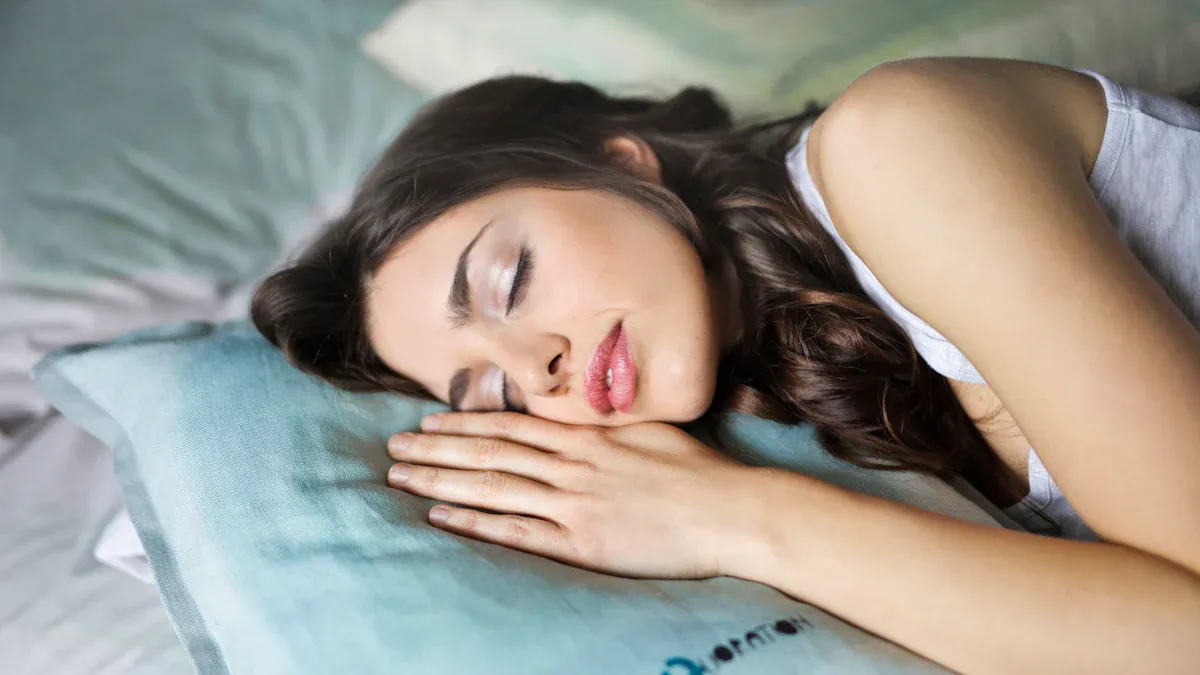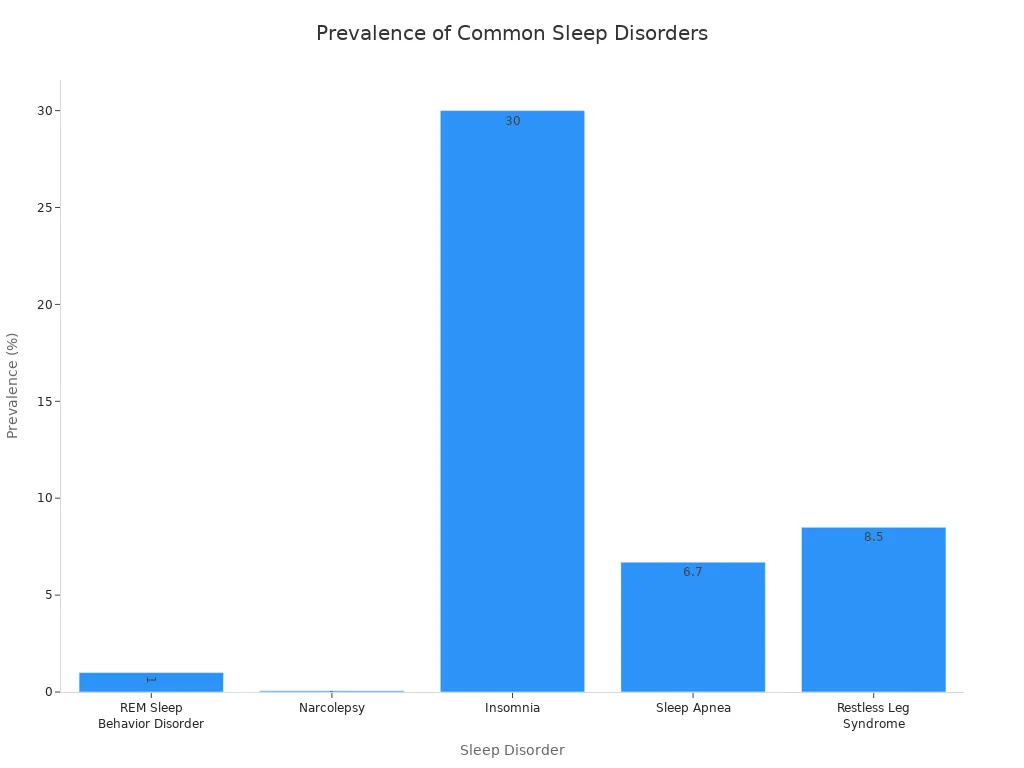
Most dreams occur during the period of sleep with dreaming known as REM sleep, which stands for rapid eye movement. This stage is unique because the brain is highly active, functioning almost as it does when you are awake. REM sleep begins about 90 minutes after you fall asleep and accounts for roughly 20-25% of total sleep time in adults. While dreams can also take place in other sleep stages, those during the period of sleep with dreaming in REM tend to feel more vivid and are easier to recall. Understanding the different sleep stages can help people remember their dreams and improve overall sleep quality.
Key Takeaways
The most vivid and memorable dreams happen in REM sleep. REM sleep starts about 90 minutes after you fall asleep. It happens many times each night. REM sleep helps your brain handle emotions and memories. This makes dreams feel real and full of feelings. You can dream in Non-REM sleep too. But these dreams are not as vivid. They are also harder to remember. Good sleep habits help REM sleep and dreams. Try to sleep at the same time every night. Make your room quiet and dark. Do not drink caffeine before bed. These things help you sleep better and dream more. Wearable devices can track your REM sleep. They help you learn about your sleep patterns. This can help your health and help you remember your dreams.
Sleep Stages

Sleep goes through a cycle that repeats. This cycle has both non-rem sleep and rem sleep. Each stage is different and helps the body in special ways. Scientists split sleep into two main types: non-rem and rem. The cycle starts with non-rem sleep. Then it moves to rem sleep. This cycle repeats every 90 to 110 minutes.
Type | Duration | Brain Wave Activity | Physiological & Behavioral Features | |
|---|---|---|---|---|
N1 | Lightest NREM | Less than 10 minutes | Alpha waves change to theta waves | Heartbeat and breathing slow down. Eyes move slowly. Muscles relax. It is easy to wake up. |
N2 | Light NREM | About 20 minutes | Mostly theta waves; sleep spindles and K-complexes show up | Heartbeat and breathing slow more. Body gets cooler. Eyes stop moving. This stage helps memory and learning. |
N3 | Deep NREM | 20 to 40 minutes | Delta waves (slow wave sleep) | Heartbeat and breathing are slowest. Muscles are very relaxed. It is hard to wake up. Sleepwalking and night terrors can happen. Growth hormone is released. |
REM | Rapid Eye Movement | Starts about 90 minutes after falling asleep; repeats in cycles | Fast, small waves like when awake | Eyes move quickly. Muscles cannot move. Dreams are vivid. Brain is very active. Brainstem controls this stage. |
Non-REM
Most of the night is non-rem sleep. There are three stages. Each stage gets deeper. Stage 1 is light sleep and lasts a few minutes. Heartbeat and breathing slow down. Stage 2 lasts about 20 to 25 minutes. The brain shows sleep spindles and K-complexes. These help with memory and learning. Stage 3 is the deepest non-rem sleep. The body fixes itself and the immune system gets stronger. It is hard to wake up from this stage. Non-rem sleep has slow brain waves, relaxed muscles, and steady breathing. Most body healing happens during non-rem sleep.
Stage 1: Light sleep, easy to wake up.
Stage 2: Deeper sleep, body gets cooler.
Stage 3: Deepest sleep, body heals and grows.
REM
Rem sleep comes after non-rem sleep. In rem sleep, eyes move fast under closed eyelids. The brain is very active, almost like being awake. Most dreams happen in rem sleep. Muscles cannot move, so people do not act out dreams. Heart rate and breathing get faster. Rem sleep helps memory and feelings. Adults spend about 20-25% of sleep in rem sleep. This stage happens many times each night.
Tip: Rem sleep is needed for strong dreams and a fresh mind. Non-rem sleep is needed for the body to heal.

REM Sleep and Dreaming
Period of Sleep with Dreaming
The period of sleep with dreaming is mostly linked to REM sleep. Scientists learned that people have the brightest dreams in this stage. The first REM period starts about 70 to 90 minutes after you fall asleep. It lasts around 10 minutes. Each period of sleep with dreaming gets longer as the night goes on. By morning, a REM period can last up to 25 minutes. Most adults have four or five REM periods each night. These periods of sleep with dreaming make up about 20–25% of total sleep time. That is about 90–120 minutes each night.
People who spend more than 25% of their sleep in REM are more than twice as likely to report vivid dreams compared to those with less REM sleep. This strong link shows why the period of sleep with dreaming is so important for dream recall.
Dreams in REM sleep often feel real and full of feelings. The brain uses this time to sort out memories and emotions. The period of sleep with dreaming also helps the mind deal with things that happened recently. These events can show up in dreams. Some people notice REM rebound after missing sleep. This means they spend more time in REM sleep the next night. REM rebound makes dreams even stronger.
Rapid Eye Movement
Rapid eye movement is a main sign of REM sleep. During this period of sleep with dreaming, eyes move fast under closed eyelids. Scientists found that special brain cells in the brainstem cause this movement. These cells release acetylcholine, which starts REM sleep and rapid eye movement. Most muscles stay still, but the eye muscles keep moving. This special activity gives REM sleep its name.
Rapid eye movement happens in short bursts. It often matches what is happening in dreams. For example, if someone dreams about watching tennis, their eyes may move side to side. This link between rapid eye movement and dream action helps scientists study the period of sleep with dreaming.
REM Brain Activity
The brain is very busy during REM sleep. EEG studies show that brain waves in REM sleep look like those when someone is awake. Both have high-frequency waves, like beta and gamma bands. But REM sleep has less power in some waves and less connection than being awake. The brain does not react to outside sounds during REM sleep like it does when awake.
Many brain parts get more active during the period of sleep with dreaming. The amygdala and hippocampus help with feelings and memories. This is why dreams often feel full of emotion. The medial prefrontal cortex and anterior cingulate cortex help with thinking about yourself and feelings. The occipito-temporal visual cortex makes clear pictures in dreams. At the same time, areas for logic and reasoning, like the dorsolateral prefrontal cortex, get less active. This may be why dreams can seem odd or not make sense.
Scientists think the activation-synthesis theory explains why REM sleep is the main period of sleep with dreaming. The brain tries to make sense of random signals during REM sleep. It creates dreams from these patterns.
REM rebound can happen after losing sleep or taking some medicines. When REM rebound happens, people spend more time in the period of sleep with dreaming. This leads to longer and stronger dreams. Some medicines, like antidepressants, and things like alcohol, can change REM sleep and cause REM rebound. These changes can make dreams more intense or cause people to act out their dreams.
Dreaming in Other Stages
Non-REM Dreaming
Many people think that dreams only happen during rem sleep, but scientists have found that non-rem sleep also includes dreaming. In research studies, volunteers wore EEG caps and got woken up during both rem and non-rem sleep. When asked, about 71% of people reported dreams after waking from non-rem sleep. This shows that non-rem sleep is not just for deep rest. It also supports dream activity.
Evidence Aspect | Description/Result |
|---|---|
Dream Recall in Non-REM Sleep | 71% of awakenings led to dream reports |
Dream Recall in REM Sleep | 95% of awakenings led to dream reports |
EEG Correlates | Decreases in low-frequency EEG in a posterior ‘hot zone' linked to dreaming in both sleep types |
Dream Content Correlation | High-frequency activity in the same brain area linked to specific dream content |
Prefrontal Cortex Activity | More activity here means better dream recall |
Implication | Dreaming happens in both rem and non-rem sleep |
Non-rem sleep dreams often feel less vivid and more like thoughts. They may connect to daily life or memories. Sometimes, non-rem dreams can be hard to remember. The brain shows special patterns during these dreams, like changes in slow wave activity and sleep spindles. These patterns help explain why dreams in non-rem sleep can be different from those in rem sleep.
REM vs Non-REM Dreams
Dreams during rem sleep and non-rem sleep show clear differences. Rem dreams are usually longer, more emotional, and more vivid. People often remember these dreams when they wake up. In contrast, non-rem dreams are shorter and less intense. They may feel more like thinking or remembering than like watching a movie.
Aspect | REM Sleep | Non-REM Sleep |
|---|---|---|
Dream Recall Rate | 43% (highest in N1, lowest in N3) | |
Dream Length | Longer, more detailed | Shorter, fewer details |
Dream Vividness | Very vivid, emotional, and bizarre | Less vivid, more thought-like |
Dream Frequency | More frequent | Less frequent |
Rem sleep dreams often include strange events, strong feelings, and creative ideas. Non-rem sleep dreams focus more on real-life memories and daily events. Scientists found that late-night non-rem dreams can sometimes look like rem dreams, especially when slow wave activity drops. Rem sleep dreams also show a “dream-lag effect,” where events from days earlier appear in dreams. Non-rem dreams do not show this effect.
Note: People who spend more time in rem sleep report more vivid dreams. Those with less rem sleep have fewer vivid dreams and may experience more bad dreams.
Improving REM Sleep
Sleep Quality
Getting good sleep helps the body and mind get enough REM sleep. People who sleep well usually spend more time in REM. This stage helps with memory, learning, and mood. If someone does not sleep enough, REM sleep goes down. The next night, the body tries to make up for it by adding more REM sleep. This is called REM rebound.
Evidence Aspect | Description |
|---|---|
Good sleep means more REM sleep. | |
If you sleep less, REM drops, but extra sleep later adds more REM. | Sleeping more after missing sleep increases REM. |
More REM sleep helps memory and thinking. | REM sleep is good for the brain. |
Going to bed at the same time and having a quiet, dark room helps REM sleep. | Good habits and a nice room help REM sleep. |
REM sleep follows the body’s clock and helps restore energy. | The body’s clock controls REM sleep and helps you feel rested. |
People can get better REM sleep by doing healthy things:
Go to bed and wake up at the same time each day.
Do not drink caffeine or alcohol before bed.
Make your bedroom cool, dark, and quiet.
Exercise often and eat foods that help sleep, like almonds and cherries.
Use screens less in the evening.
Tracking REM
Tracking REM sleep helps people learn about their sleep and health. Wearable devices, like the VERTU Aura Ring, use sensors to measure REM and other sleep stages. The Aura Ring checks heart rate, body temperature, and movement to give REM data. Studies show that ring-type devices, like the Aura Ring, track REM sleep well. They are over 85% accurate compared to medical tests.
Wearable Type | Key Sensors & Features | REM Sleep Tracking Effectiveness |
|---|---|---|
Ring-type devices | Heart rate, movement, temperature, circadian rhythm | These devices are accurate and do not have much bias. |
Watching REM sleep can help people remember dreams better. Research shows that some brain activity during REM can tell if someone will remember dreams. Tracking REM sleep also helps find changes linked to health problems, like heart issues or memory loss. By using devices like the Aura Ring, people can make better choices to improve REM sleep and health.
Tip: Using smart wearables to track REM sleep can help people see patterns, remember dreams, and stay healthy.
REM sleep is when most bright dreams happen. It helps people remember things and feel better. This stage also helps with new ideas and mood. People can get more REM sleep by going to bed at the same time. They should not drink caffeine or alcohol before bed. A quiet and peaceful bedroom helps too. Smart health devices can show how someone sleeps. These tools help people see changes in their sleep. Learning about your own sleep can help you know your dreams. It also helps you feel healthier.
FAQ
What is REM sleep?
REM sleep stands for Rapid Eye Movement sleep. The brain becomes very active during this stage. Most vivid dreams happen in REM sleep. The body’s muscles stay relaxed, but the eyes move quickly under closed eyelids.
Can people dream in non-REM sleep?
Yes, people can dream in non-REM sleep. These dreams usually feel less vivid and more like simple thoughts. Scientists found that dreams can happen in all sleep stages, but REM dreams are easier to remember.
How can someone improve REM sleep?
People can improve REM sleep by keeping a regular sleep schedule, making the bedroom dark and quiet, and avoiding caffeine before bed. Exercise and healthy foods also help. Smart rings like the VERTU Aura Ring can track REM sleep for better results.
Why do some dreams feel so real?
Dreams feel real during REM sleep because the brain’s emotion and memory centers become very active. The brain creates strong images and feelings, making dreams seem lifelike and sometimes emotional.
Does tracking REM sleep help with dream recall?
Tracking REM sleep helps people notice patterns in their dreams. Devices like the VERTU Aura Ring show when REM sleep happens. This information can make it easier to remember dreams and understand sleep habits.








